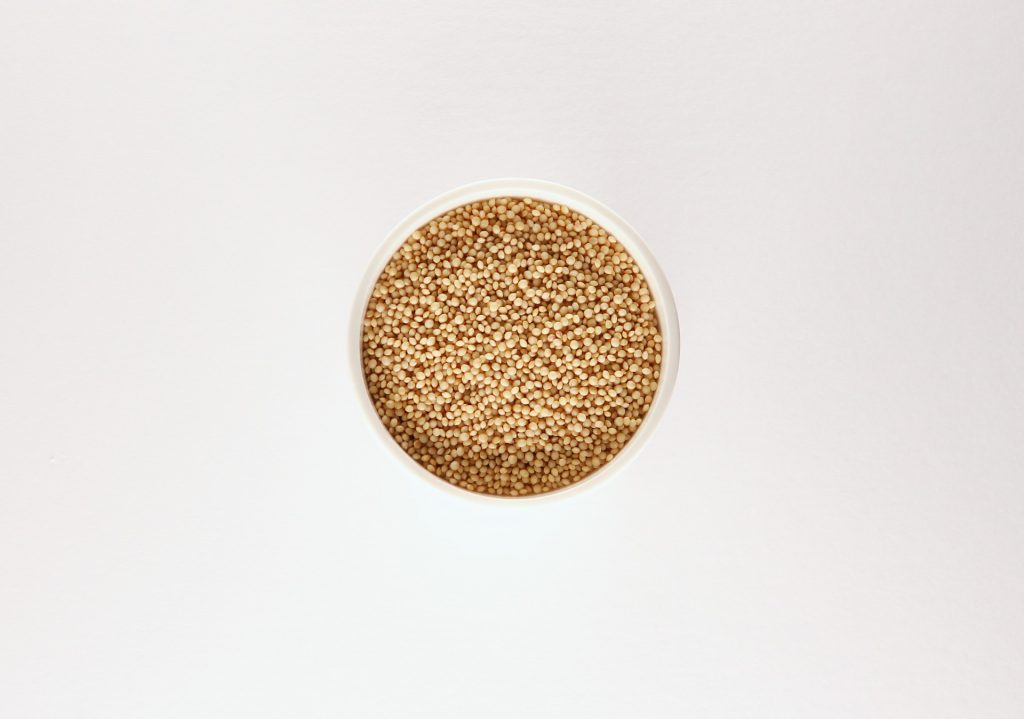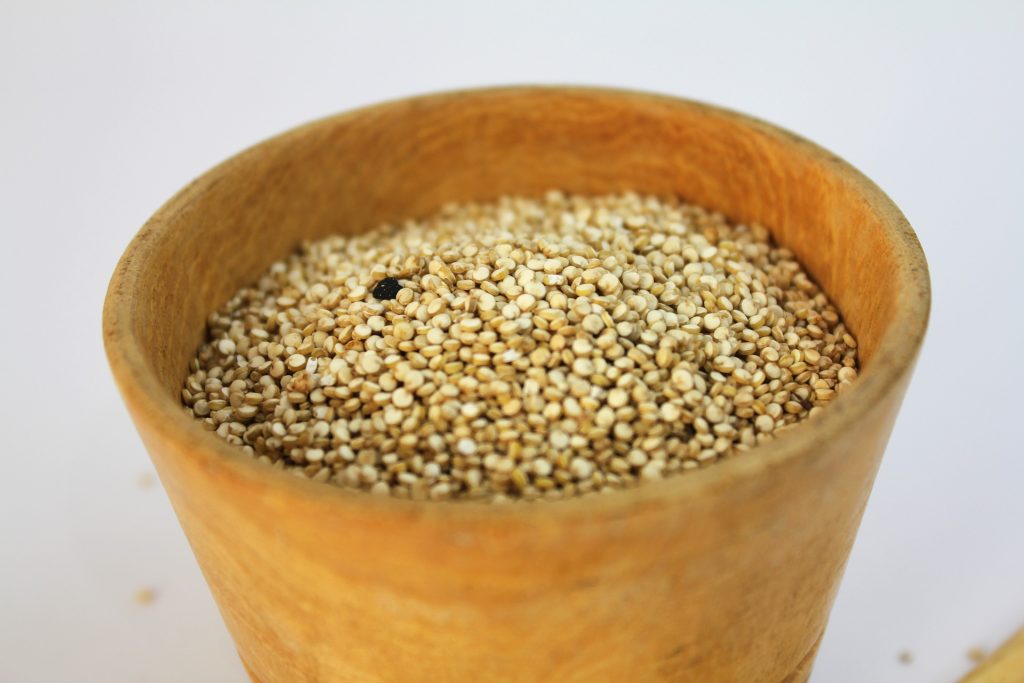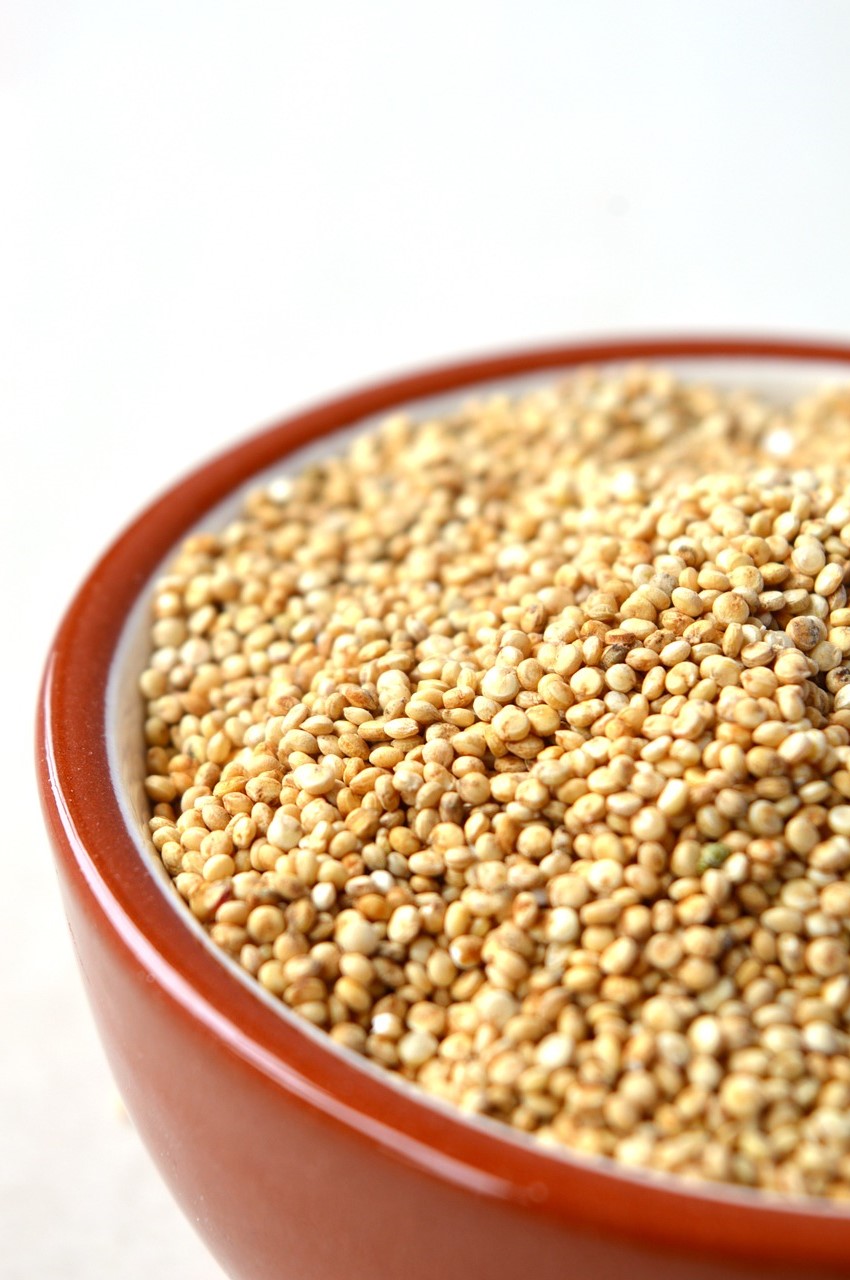The name for Amaranth comes from the Greek amarantos, “one that does not wither,” or “the never-fading”; such is the hardy nature of this plant.
Flaked Organic Amaranth
(gluten-free)
These amaranth flakes are simply amaranth grain, rolled into these miniature flakes. They are suitable for making a smooth and creamy gluten-free porridge, as well as adding to soups to thicken and provide texture.
- Gluten-free.
- Good source of protein.
- Use as a breakfast cereal or in muesli.
- Can also be cooked in a porridge.
- Can be mixed with other gluten-free flakes.
These tiny (3mm) flakes are a very versatile ingredient. Amaranth is full of protein and can be used as a breakfast cereal, in muesli or cooked into a porridge.
Directions for use
- Use as a breakfast cereal, in a similar manner to cornflakes. These flakes retain their crunch when soaked.
- Use these flakes in a muesli mix. They are gluten-free, so are ideal in a gluten-free muesli.
- To make porridge, boil these amaranth flakes in a little water for 5 minutes before adding milk, honey and fruit to taste.
- Thicken soups by adding a handful of these flakes.
- Add these flakes to cakes, cookies and bread, in a similar way to how one would use oat flakes.
More Info on Amaranth
Latin Name
Amaranthus
Also Known As
Amaranto, Chua, Huantli, Huatlí, Lady Bleeding, Love-Lies-Bleeding, Pilewort, Prince’s Feather, Ramdana, Red Cockscomb, Rhamdana, Velvet Flower.
Origin
South America
Parts Used
Seeds
Traditional Use & Health Benefits
The name for Amaranth comes from the Greek amarantos, “one that does not wither,” or “the never-fading”; such is the hardy nature of this plant.
Amaranth is often mistaken for a cereal grain due to its similar appearance and nutritional profile, when it is actually a seed. This gluten free pseudo-grain was a favourite of the Aztecs, Incas and Mayan peoples due to it packing a powerful, protein packed punch.
Amaranth was almost wiped out by the Spanish and Portuguese conquistadors. Luckily small patches survived in the wild and lofty Andean mountains and it is enjoying a revival as yet another highly nutritious, ancient South American superfood.
Amaranth Benefits
Highly Nutritious
Boasting some impressive nutritional statistics, Amaranth is first and foremost a complete protein. Containing all of the essential amino acids, “Amaranth’s amino acid profile is as close to perfect as you can get for a protein source” according to Pete Noll of the Oaxaca based advocacy group “Puente a la Salud Comunitaria” (Bridge to Community Health).
Like its cousin quinoa, Amaranth is extremely mineral rich, especially in the heart healthy magnesium, with just one serving providing almost half of the body’s daily needs. It will also provide over 100% of the daily requirements for manganese, a vital mineral for metabolism and 30% of the daily requirement for iron.
Amaranth is also gluten free, allowing for easier digestion, the addition of this grain is also excellent way to boost the nutritional power of gluten free recipes.
Antioxidant
Amaranth is a great source of health promoting antioxidants including; gallic acid, p-hydroxybenzoic acid and vanillic acid. These belong to the group of antioxidants known as “phenolic acids”. These compounds have been studied mainly for their properties against oxidative damage leading to various degenerative diseases, such as cardiovascular disease and the low-level inflammation that can lead to all sorts of debilitating health conditions.
Healthy Weight Loss
High in protein and fibre, Amaranth eaten as part of a protein rich breakfast can decrease levels of the hunger hormone, ghrelin. Being a complete protein, it can slow down the rate at which sugar is absorbed into the bloodstream, reducing insulin, hunger levels and making it easier for the body to burn fat.
Also high in fibre, Amaranth moves more slowly through the digestive system, helping to keep you feeling fuller for longer.
Digestive Health
The high fibre content of Amaranth is mainly responsible for its digestive benefits – it contains 78% insoluble and 22% soluble fibre. Insoluble fibre is not broken down in the gut and adds bulk to waste in the digestive system, promoting the regularity of bowel movements and taking unhealthy toxins and fats with it.
Soluble fibre is broken down and fermented in the colon, resulting in a gel-like substance that lubricates the intestinal tract, slowing down digestion whilst allowing for maximum absorption of all of the minerals found in Amaranth. Soluble fibres also contain prebiotics – providing the food and fuel for important probiotics to use in the colon.
Typical Use
Amaranth grain can be used as a cereal, an alternative to rice or puffed and popped like popcorn.
Amaranth flour has an intense, nutty flavour and is most commonly used in recipes in a proportion of 1 part to 3 parts of other flours.
Constituents
Amino Acids, Vitamins B1, B2, B3, B6, Pantothenic Acid (B5) and Folate (B9). Minerals; Calcium, Iron, Magnesium, Manganese, Phosphorus, Potassium and Zinc.
Phytonutrients include: squalene, tocopherols, phenolic compounds and phytates.
Precautions
None known, although the effects of Amaranth have not been studied in pregnant or breastfeeding women.
Folklore & History
The cultivation of Amaranth is evident as far back as 8,000 years ago, when the Aztecs not only used it as a source of nutrition; they built statues of their gods using Amaranth and honey. Once the statues had been worshipped they were broken and distributed to eat, however when Cortés arrived to conquer the Aztec Empire, this practice was soon stamped out. In their efforts to force Christianity on the “pagan natives”, cultivation of Amaranth was outlawed, the fields were burned and its cultivators were punished.
The lesser known Mixteca of Oaxaca also recognized the great importance of Amaranth. They fasted and made a statue out of Amaranth of the god “Huitzilopotchtli”, who they referred to as: the Dart-Hurler or the Divine Hurler. A precious, Post-classic turquoise mosaic covering a skull found in Tomb 7 at Monte Alban was actually kept together by a sticky Amaranth paste.




